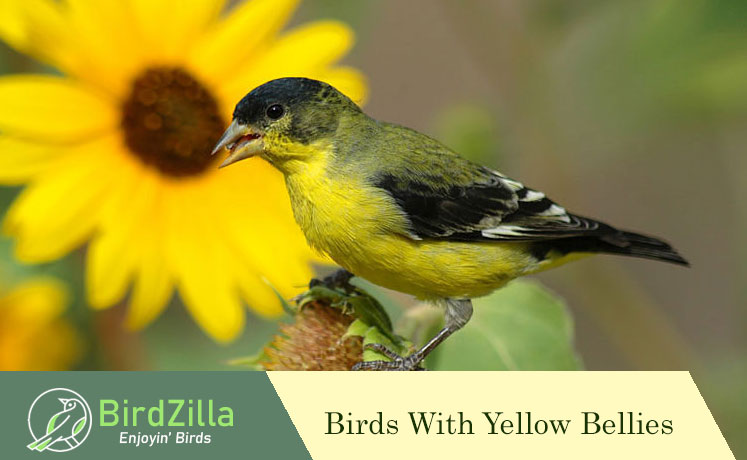
Birds with yellow bellies surround us everywhere we go. As luck would have it, bright and cheerful yellow is one of the more common colors in the avian world.
As with other bright colors, yellow is mostly used by male birds to attract a mate, and by females to help them blend in with summer foliage. Do you wonder which birds with yellow bellies visit your backyard?
See our list of common birds with yellow bellies!
On this page
- #20 Great Crested Flycatcher
- #19 Yellow Warbler
- #18 Orange-crowned Warbler
- #17 Canada Warbler
- #16 Scott’s Oriole
- #15 Western Kingbird
- #14 Hooded Warbler
- #13 Lesser Goldfinch
- #12 Common Yellowthroat
- #11 Altamira Oriole
- #10 Wilson’s Warbler
- #9 Western Meadowlark
- #8 Yellow-bellied Sapsucker
- #7 Prairie Warbler
- #6 Western Tanager
- #5 Yellow-breasted Chat
- #4 Kentucky Warbler
- #3 Great Kiskadee
- #2 Cedar Waxwing
- #1 American Goldfinch
#20 Great Crested Flycatcher
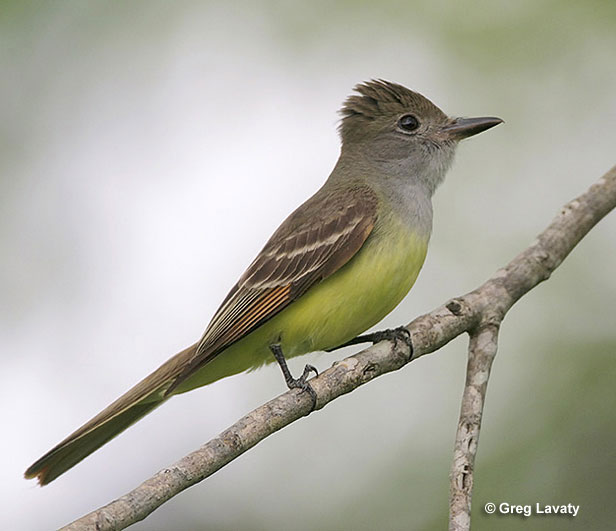
The Great Crested Flycatcher is a medium-sized, crested flycatcher species with olive-brown upperparts and two pale wing bars. It also has pale yellow underparts with a pale gray throat and gray chest, and a few small white marks on the back part of its wings.
Males and females look alike and have red-brown in their wings and tail, and a thick, dark beak with a pinkish base.
Great Crested Flycatchers breed in woodland habitats in central and southeastern Canada, and in the eastern USA. They winter in tropical dry forest and other tropical habitats from southern Florida to Central America, and northern South America.
#19 Yellow Warbler
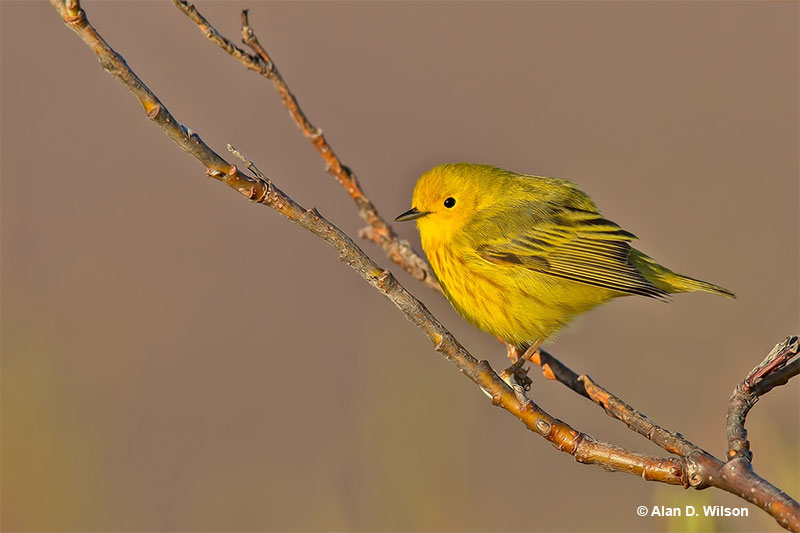
© Alan D. Wilson
Yellow Warblers are small, mostly yellow birds with yellow bellies.
Male Yellow Warblers are rich golden yellow below with olive on their back, wings, and tail. They also have red-brown streaking on their underparts.
Female and young Yellow Warblers can have yellow-olive or grayish upperparts, and have plain yellow or dingy yellow underparts.
In summer, we see this species in a variety of second growth and edge habitats in Alaska, much of Canada, and the USA south to California and northern Georgia. For the winter, they migrate to edge habitats from Mexico to northern South America.
#18 Orange-crowned Warbler
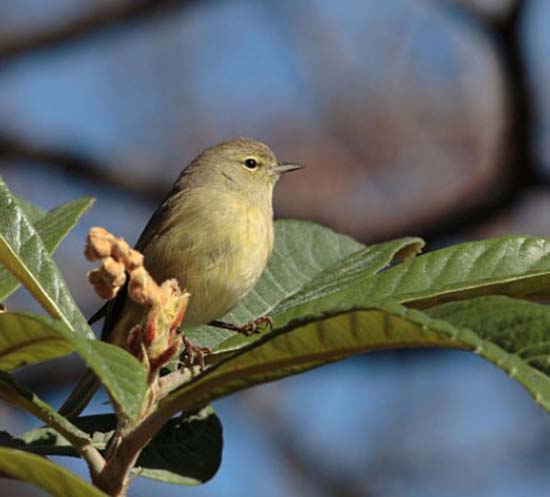
The Orange-crowned Warbler is a small, dull bird with a yellowish undertail that can be olive-gray, or dingy yellow and olive. They also have a dark line through their eyes and a pale broken eyering.
Adult males are more richly colored than females and young birds, and have blurry olive streaks on dingy yellow underparts.
Female and young Orange-crowned Warblers are like dull versions of the male. Some are mostly gray but always have yellow on their undertail.
This species breeds in shrubby habitats in Alaska, northern Canada, and in the western USA. It winters in the southern USA to Guatemala.
#17 Canada Warbler
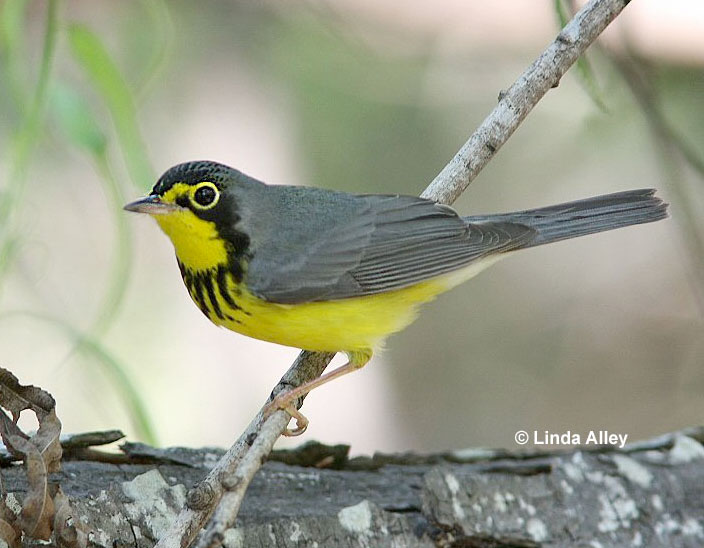
The Canada Warbler are small birds with yellow bellies and dark dray uppersides. Males are rich, golden-yellow below with a thick, mottled black “necklace”. They also have yellow in front of their eyes, some black on the front of their crowns and face, and a white undertail.
Females and juveniles look like paler and less boldly patterned versions of the male.
Canada Warblers breed in moist mixed forests with a dense understory in central and eastern Canada, the northeastern USA, Great Lakes Region, and the Appalachians. They winter in montane tropical forest habitats in northern South America.
#16 Scott’s Oriole
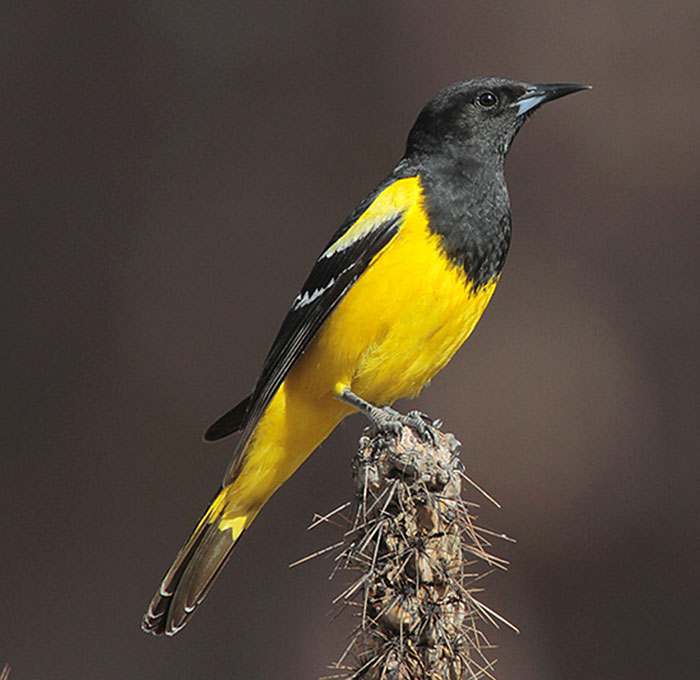
Photograph © Greg Lavaty
The Scott’s Oriole is a blackbird-sized, black and yellow oriole with a sharp black beak. Males have a black hood, back, and chest, and black and white wings with a dark yellow shoulder.
They also have a rounded black tail with a clear yellow base, and a clear yellow rump and lower black. The belly and undertail are bright golden yellow.
Female and juvenile Scott’s Orioles are more grayish with less black on their back and throat. They also have dingy yellow on their underparts and rump.
This species lives in montane arid habitats in the western USA from southern Idaho to California, western Texas, and Mexico.
#15 Western Kingbird
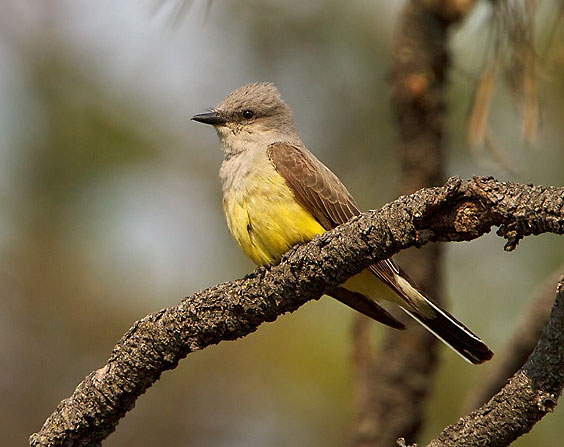
The Western Kingbird is a flycatcher with white sides on its longish, rectangular black tail. Around the same size as a Red-winged Blackbird, it has a gray head, a hint of a dark mask, and a pale throat. It also has a pale gray chest and gray-olive back and long, olive-brown wings.
Male and female Western Kingbirds look the same and also have a clear yellow belly and undertail.
This noisy species lives in grasslands and other open habitats in parts of southern Canada east to Saskatchewan. They also loccur in the western USA from Washington east to western Wisconsin and south to Mexico.
#14 Hooded Warbler
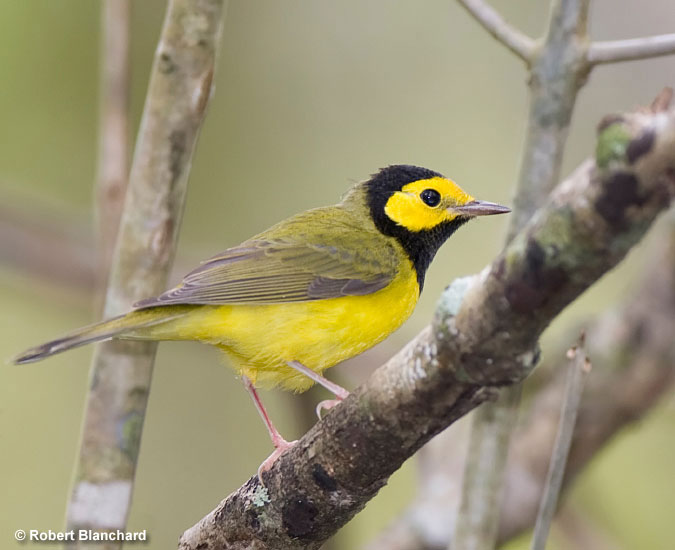
The Hooded Warbler is a small bird with a bright yellow face. It also has plain olive upperparts and a longish tail with white outer tail feathers.
The male Hooded Warbler has a black throat and black that outlines its shining yellow face. Female Hooded Warblers don’t have any black on their throats and only a hint of black on the back side of their yellow face.
Both sexes have bright yellow on the rest of their underparts.
In summer, this warbler lives in the undergrowth of deciduous forests in southern Ontario and the eastern USA. It winters in tropical forests in the Caribbean, Mexico, and Central America.
#13 Lesser Goldfinch
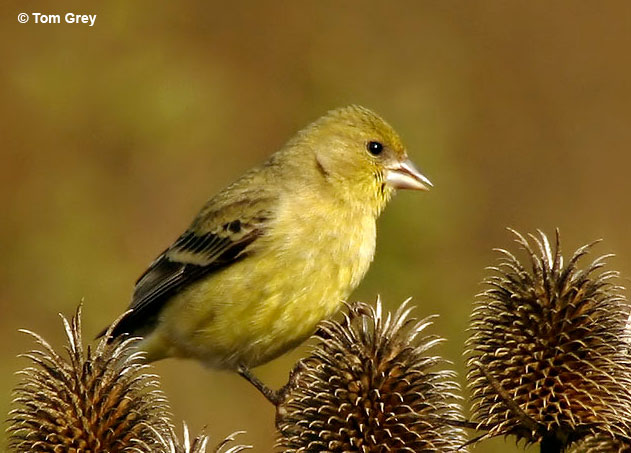
The Lesser Goldfinch is a small finch with a strong, conical beak, short, forked tail, and has white patches in its black wings. Males can be black above with rich yellow underparts, or be olive above with a black cap and pale yellow underparts.
Female Lesser Goldfinches have less black in their wings and plain olive upperparts. Their underparts are rich yellow or pale yellow and white.
This species lives in oak woodlands and grassy, arid habitats in the western USA from Oregon and Idaho south to Texas and Mexico. It also lives in Central America and parts of northern South America.
#12 Common Yellowthroat
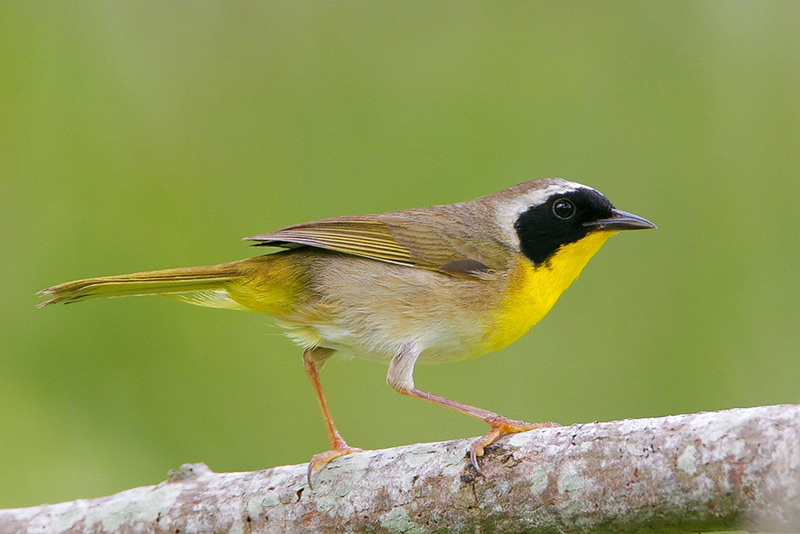
Photograph © Greg Lavaty.
The Common Yellowthroat is a small warbler with pale olive and gray-brown upperparts, and a sharp dark beak. They also have a yellowish undertail, pale belly, and a bright yellow throat and chest.
Male Common Yellowthroats have a frosty pale border on the top part of their thick, rectangular black mask. Females lack the black mask and have a broken pale eyering on their pale brown and grayish face.
We see Common Yellowthroats in thick, wet grass and in wet second growth. They breed in much of Canada, and most of the lower 48 states except for the arid southwestern states.
#11 Altamira Oriole
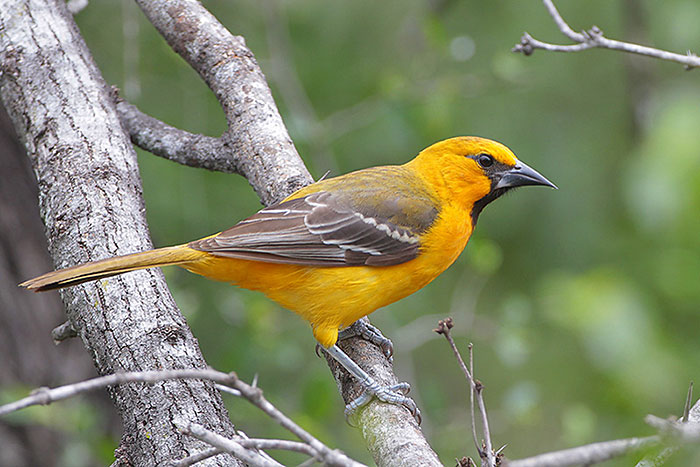
The Altamira Oriole is big, orange and black oriole. It has a thick, sharp black beak with a bit of gray on its base, and black in front of its eyes and on its throat.
This oriole has a yellow-orange patch on the shoulder of each of its black and white wings, a longish black tail, and black patch on its back.
Males and females look the same but juveniles are paler, have an olive back, and can show more yellowish-orange on their underparts.
Altamira Orioles live in subtropical woodlands and similar habitats from the southern Rio Grance Valley of Texas south to Nicaragua.
#10 Wilson’s Warbler
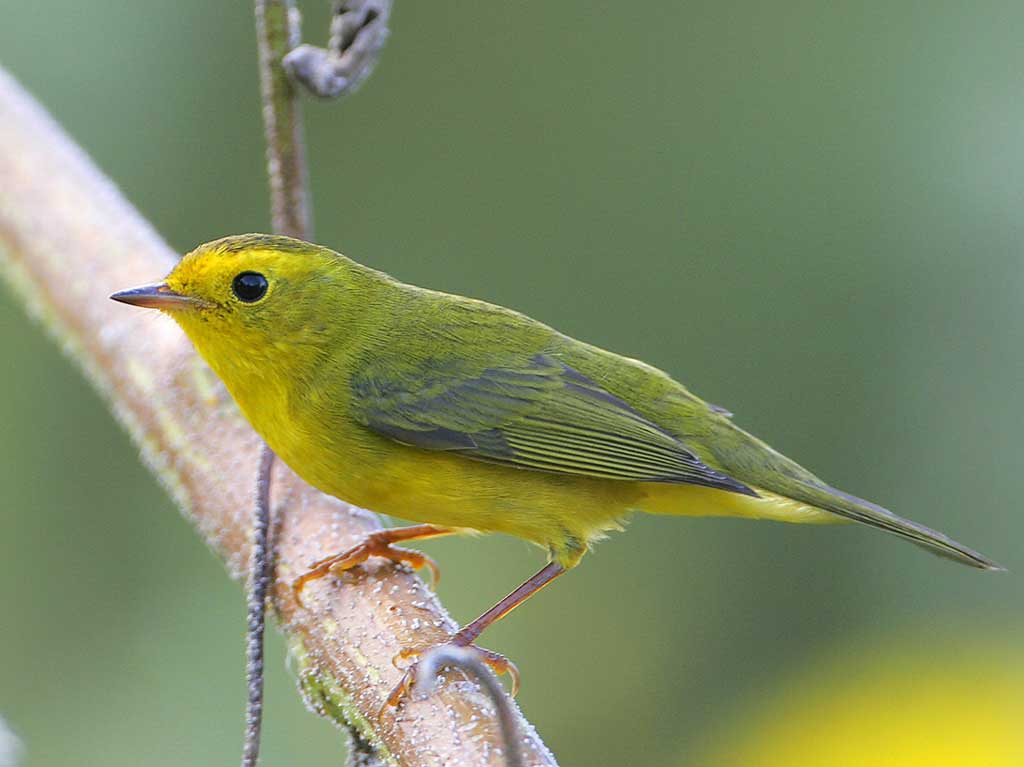
The Wilson’s Warbler is a small, yellowish warbler with olive on its back, wings, and tail. Males have a contrasting black cap while females can have a grayish or olive cap.
Some of these warblers have clear yellow on their underparts and face, while other subspecies can have deeper, orange-yellow in their face and throat.
We can recognize Wilson’s Warblers by their plain yellow and olive coloration, and dark olive tail lacking white or yellow spots.
This species breeds in shrubby habitats in Alaska, Canada, the western USA, and Maine. It winters in shrubby and montane habitats from Louisiana to Panama.
#9 Western Meadowlark
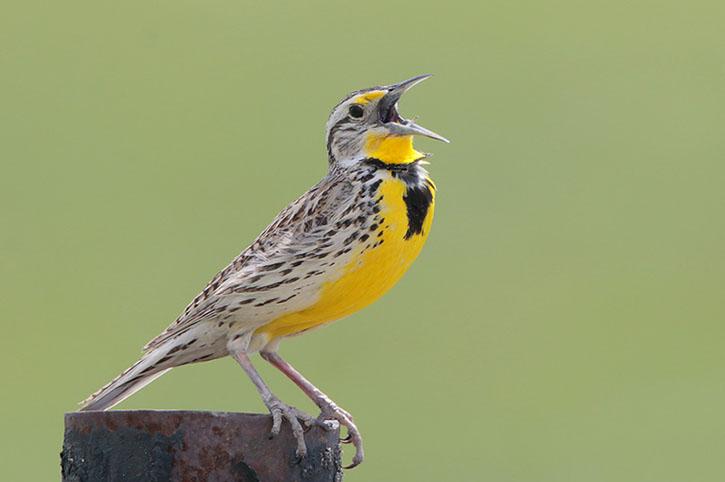
The Western Meadowlark is a rotund, chunky blackbird species with a long, sharp beak, and a beautiful, short melodious song.
This species has mottled pale brown upperparts, a black and white head, and a pale brown and white tail with some dark barring. It has deep yellow on its throat, the lowest part of its face, in front of its eyes, and on much of its underparts.
Both sexes look the same, have a big, “V”-shaped patch on their chest, and dark marks on white sides but males usually have brighter yellow plumage.
Western Meadowlarks live in sparse, open habitats from the western USA and Canada east to the Great Lakes region.
#8 Yellow-bellied Sapsucker
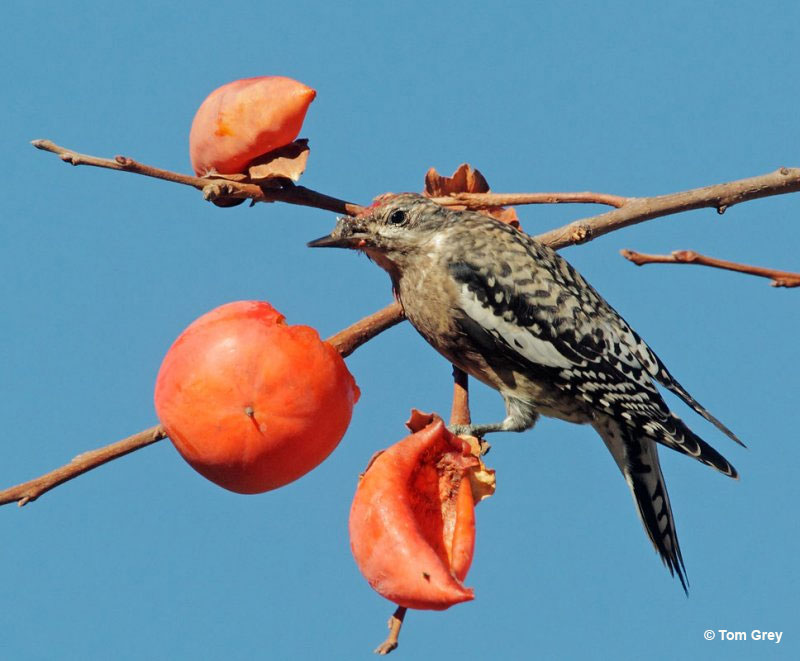
© Tom Grey
The Yellow-bellied Sapsucker is a medium-sized, handsome woodpecker with a mottled black and white back, white patch on each wing, and a black patch on its chest.
The rest of its underparts are white and pale yellow with some fine black streaks.
The male Yellow-bellied Sapsucker has a red throat and crown, while the female has a white throat. She can also have a red or a black crown.
This species breeds in forests in eastern Alaska, much of Canada, and from North Dakota east to Maine and south to West Virginia. It winters in woodlands from New Jersey and southern Illinois to the Caribbean and Panama.
#7 Prairie Warbler
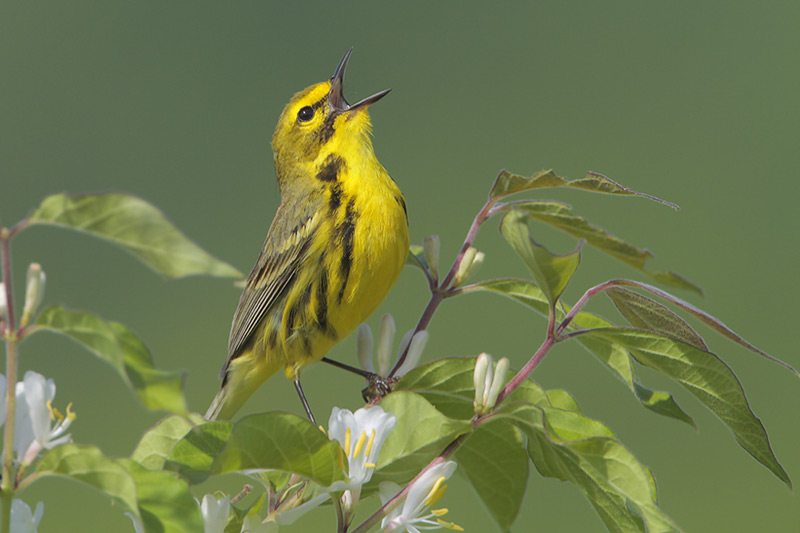
The Prairie Warbler is a small warbler with a plain olive back and wings, and a longish tail. Males have deep yellow underparts with a few thick black streaks on their sides, a thick yellow eyebrow, and a yellow mark below each eye.
Males and females also have small chestnut streaks on their back but female Prairie Warblers are paler yellow below, and have whitish markings above and below their eyes. Young birds look like females but have grayish heads and a hint of streaks on their sides.
This species lives in shrubby fields and second growth in the eastern USA. It winters in Florida and the Caribbean.
#6 Western Tanager
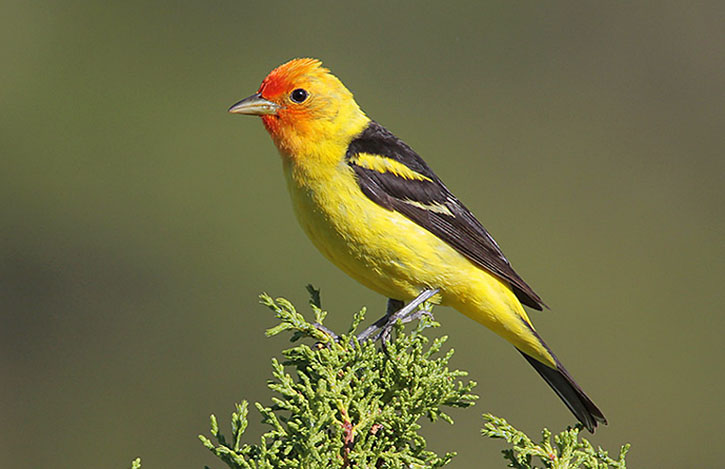
Western Tanagers are beautiful birds with yellow bellies. Males have a black upper back, rose-colored head, and beautiful lemon yellow on their rump, lower back, and underparts.
Female Western Tanagers are pale gray and yellow-olive above, usually have a narrow yellow eyering, and dingy yellow below.
In the summer, this species frequents coniferous and oak woodlands west of the Rocky Mountains from northern Canada south to southern Arizona. It winters in tropical dry forest and montane woodlands from Mexico to Panama.
Western Tanagers are common visitors to wooded backyards.
#5 Yellow-breasted Chat
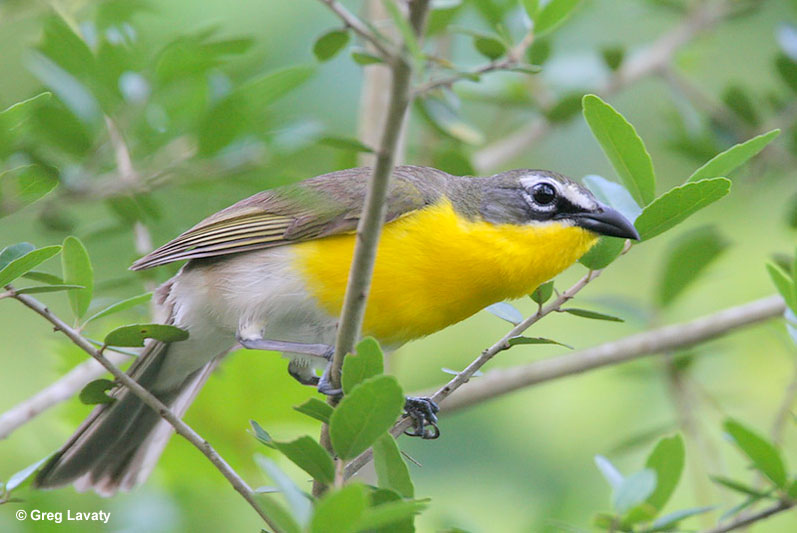
The Yellow-breasted Chat is a medium-sized songbird that has white spectacles on its grayish head, a bit of black in front of and below its eyes, and a thick black beak.
Males and females look the same and have a small white moustache mark, and plain gray and olive upperparts. They also have a deep, orange-yellow throat and chest, and white belly and undertail.
In summer, this unique bird skulks in thickets and old, brushy fields in parts of southern Canada, and many areas of the lower 48 states north to New York, southern Michigan, and Washington. They migrate to Mexico and Central America for the winter.
#4 Kentucky Warbler
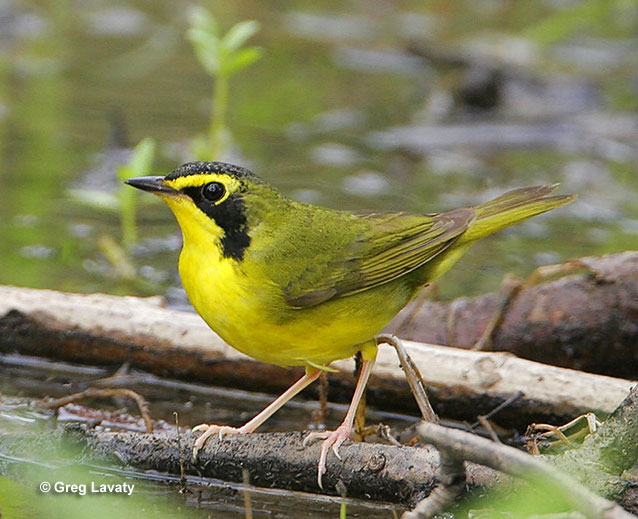
Kentucky Warblers are small, beautiful beautiful birds with yellow bellies. They also have olive-brown upperparts, and pink legs and feet.
Male Kentucky Warblers have a contrasting black crown, and thick black mask on the lower part of its face. Females look like males but don’t’ have as much black on their head and face.
In the summer, we find Kentucky Warblers in the undergrowth of mature deciduous forests from Wisconsin and New Jersey south to northern Florida. For the winter, they migrate to tropical forests in the Caribbean, Central America, and northern South America.
#3 Great Kiskadee
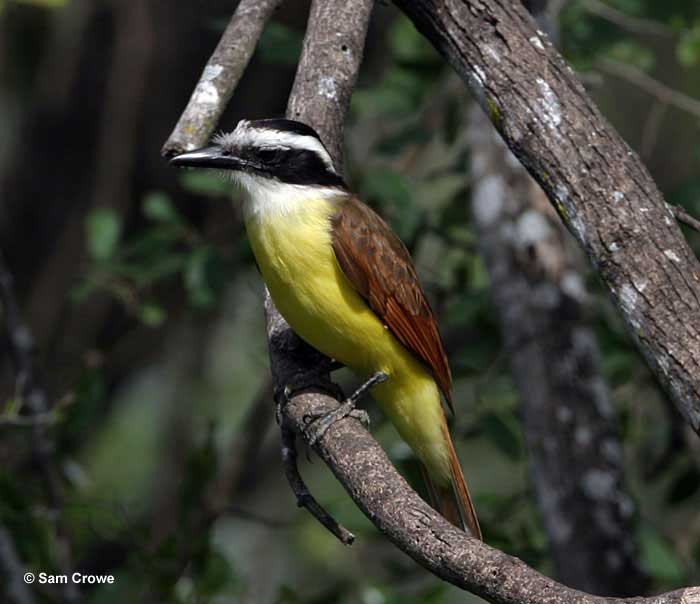
The Great Kiskadee is a big, hefty, and bold flycatcher with a black and white head, and strong, thick beak. Males and females look the same and have brown upperparts with red-brown highlights in their wings and tail.
We can also recognize Great Kiskadees by their bright yellow underparts with a white throat, and boisterous call, “Kis-kuh-dee!”.
Great Kiskadees are common, tropical birds of woodlands, the edges of lagoons and other wetlands, and other edge habitats from the southern Rio Grande Valley in Texas south to Argentina. They also live in urban areas, backyards, and can visit fruit feeders.
#2 Cedar Waxwing
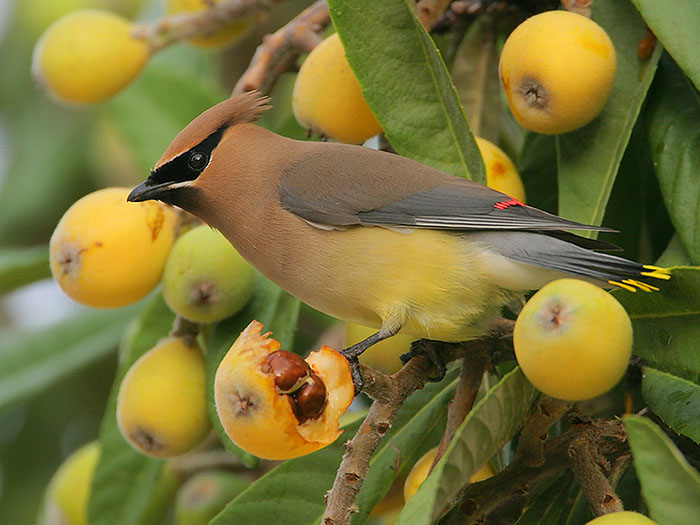
The Cedar Waxwing is a sleek, pleasant brown and gray bird with a yellow belly. Both sexes look pretty much the same and have a bright yellow tip on their dark gray tails, and pale yellow bellies.
Depending on the lighting, the yellow on this bird’s belly can look paler or brighter yellow. They also have black on their throat and in front of their eyes, and long wings with a bit of white and a few tiny red dots.
Cedar Waxwings thrive in parks and woodlands in Canada, and all the lower 48 states south to Central America.
#1 American Goldfinch

The American Goldfinch is a small bird with a yellow belly and chest and blackish plumage. Breeding males have bright and beautiful, lemon-yellow plumage, a neat black cap, white undertail, and a white rump.
Female American Goldfinches are plain pale brown birds with dingy yellow highlights on their heads, and buff wing bars. In winter, males look like females but are more yellow and olive.
We see these pretty little finches at feeders, in parks, brushy fields, and other edge habitats in many parts of Canada, throughout the lower 48 states, and in parts of Mexico.

